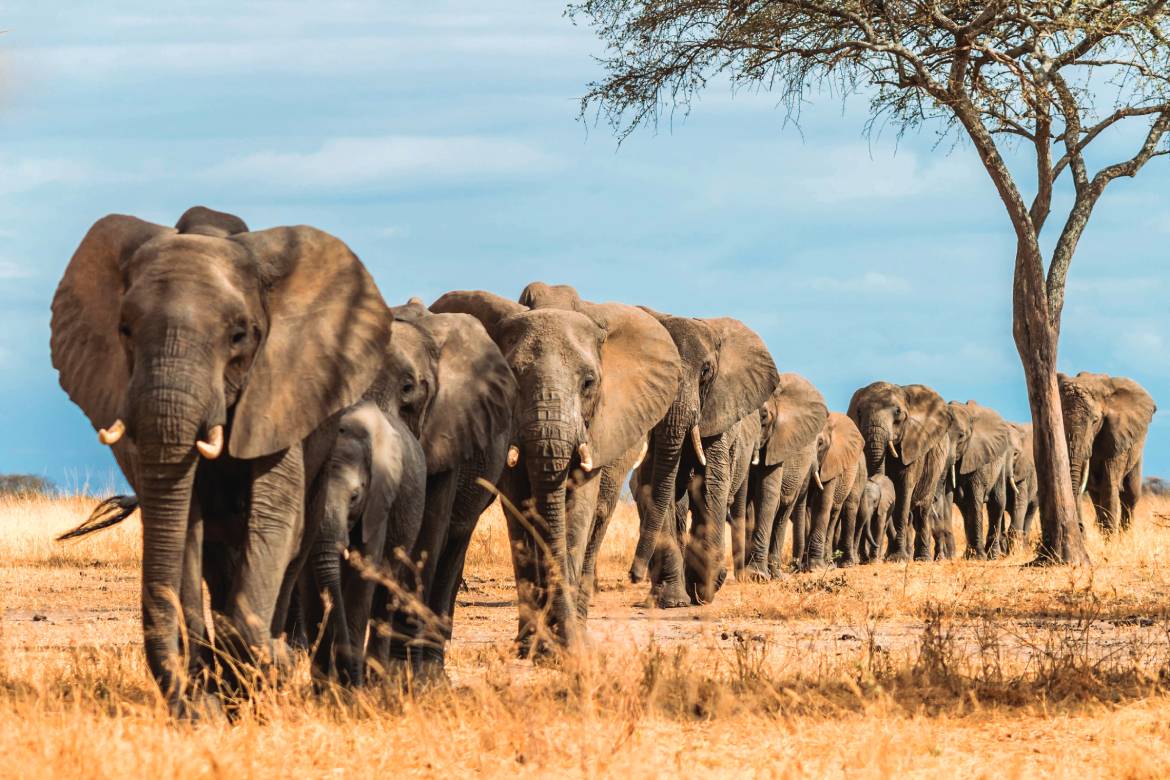Tanzania is a popular vacation destination in East Africa known for its stunning wildlife and natural landscapes.
“Miss, I’m sorry, you can’t go to your room. There are elephants blocking your tent.” My guide’s voice was firm as he redirected me down a gravel pathway and I stared, awestruck, while a herd of lumbering, seven-ton beasts meandered through our camp, grazing. A calf zigzagged through the maze of its mother’s legs as an elderly bull with enormous tusks feasted on a branch a mere hundred feet from where I stood. Palms clammy and pulse elevated, I took a deep breath and did the only sensible thing I could think of: grab a beer from the dining hall and watch.
It was only my second night in Tanzania, the east African country famed for its national parks and wildlife, and my mind was already spinning with the lightheadedness that only comes from new experiences. I didn’t know it yet, but these tell-tale symptoms of awe–gripped heart, lifted stomach, and a smile as wide as the sky, would soon become the norm as I ventured deeper into the country’s wilderness.
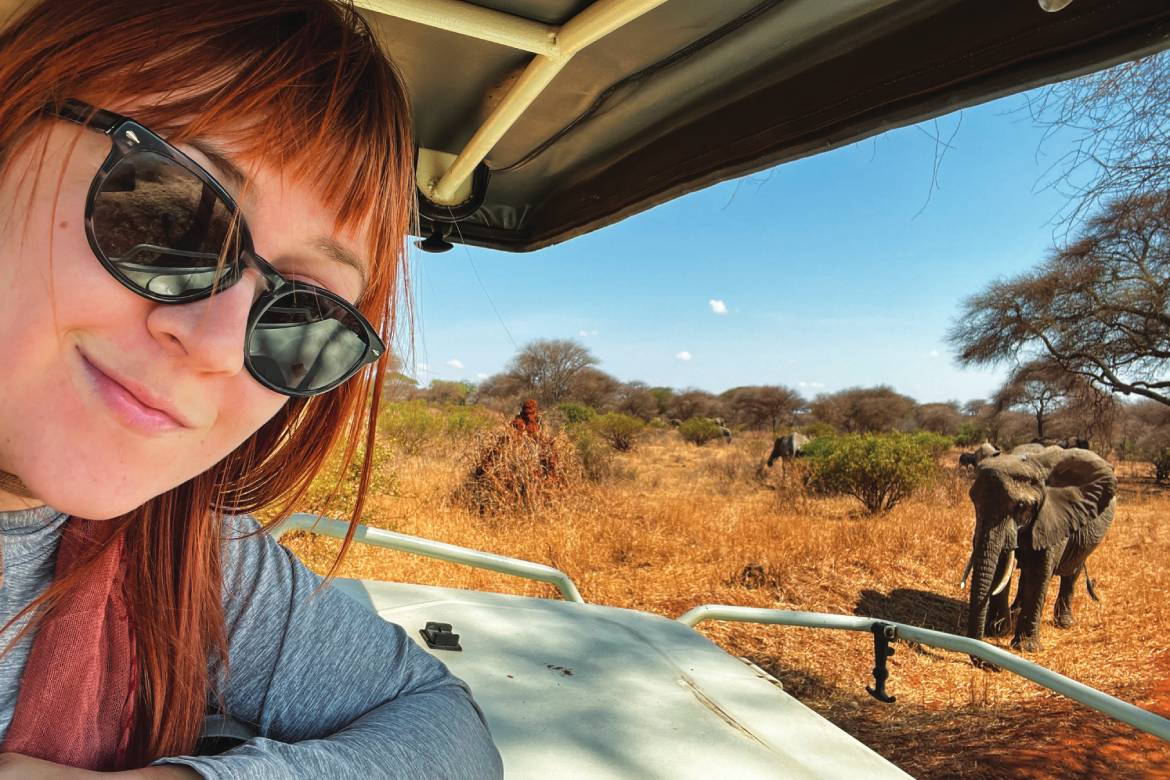
Emily With Elephant in Tarangire National Park (Photo by Emily Pennington)
Situated just south of Kenya, on the western edge of the Indian Ocean, Tanzania has an outstanding reputation for preserving its natural landscapes. Roughly 37 percent of the country is covered by some form of conservation rules, with a tapestry of twenty-two national parks offering the highest protections for native flora and fauna. It’s a place revered for its wild spaces, from glacier-capped Kilimanjaro to the sprawling plains of the Serengeti, and, with over ten percent of its annual GDP coming from tourism, being a good custodian of nature is high on the country’s priority list.
My tour company for the week-long loop around Tanzania’s “northern circuit” of Tarangire National Park, Elewana Arusha Coffee Lodge, and Serengeti National Park was the legendary Abercrombie & Kent (abercrombiekent.com), purveyors of luxurious, locally-guided small group trips across the globe with a special focus on far-flung African countries. The company, which was founded in 1962 to open-up destinations previously inaccessible to western tourists, was celebrating its 60th anniversary, and I couldn’t imagine being in better hands..
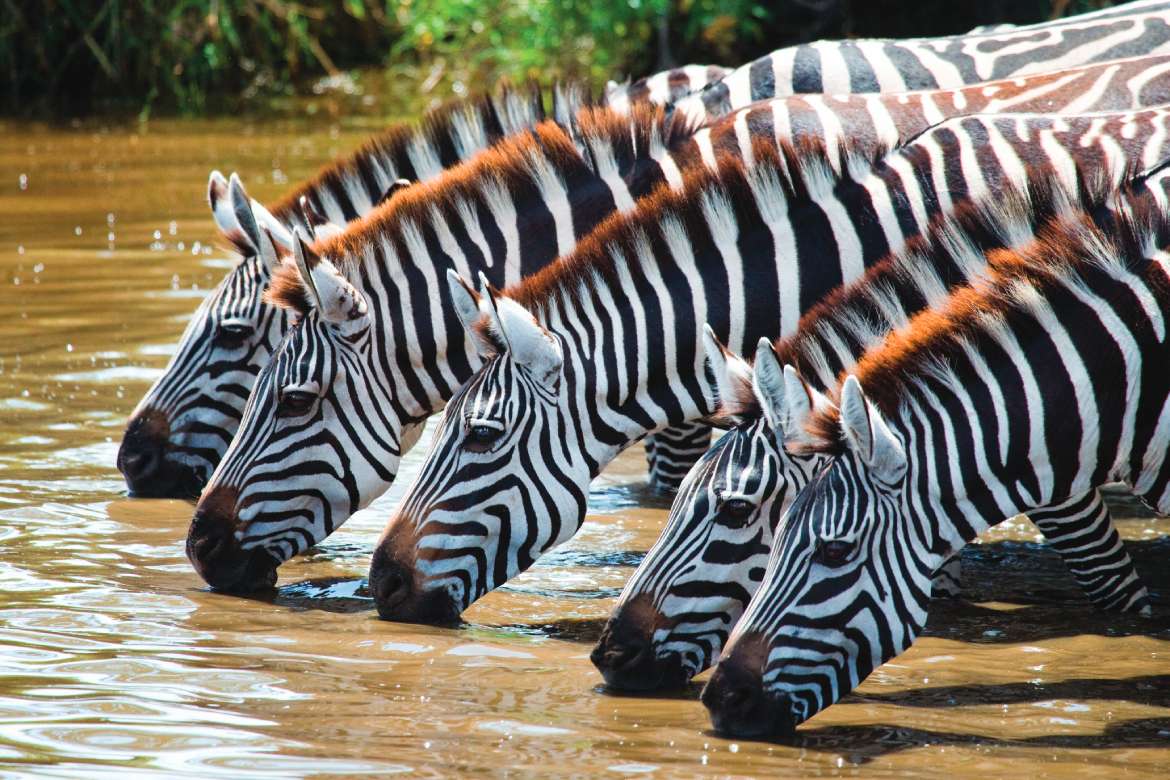
Zebras in Serengeti National Park (Photo by Gudkov Andrey)
Though Tanzania’s preserved spaces run the gamut from high-altitude volcanic summits to Jane Goodall’s famous chimps in Gombe, my eight day journey was centered around observing Africa’s “big five” in person. The term was originally coined by big game hunters to evoke the difficulty and danger in catching (and killing) elephants, lions, rhinos, leopards, and cape buffalo, but now serves as a bucket list of charismatic megafauna for every amateur photographer and animal lover that sets foot in the country.
ARUSHA
The wheels of my plane touched down at the Kilimanjaro International Airport in Arusha during the inky black of night. After a friendly driver grabbed my luggage and shuttled me past colorful villages alive with sizzling street food and thumping dance music, I arrived at my first hotel, Elewana Arusha Coffee Lodge (elewanacollection.com). The high trill of insects served as a backdrop as an attendant led me to an elegant dark wood bungalow surrounded by lush gardens and coffee trees. I took a soak in the extra-large tub using the property’s bespoke, scented bath salts to wash the ache of 22 hours of plane travel out of me.
Breakfast in the lodge’s sunshine-filled dining hall was punctuated by many, many cups of much-needed local coffee. I figured I’d need the extra lift, considering that the next item on the agenda was a meeting with my guide and fellow safari companions for the week.
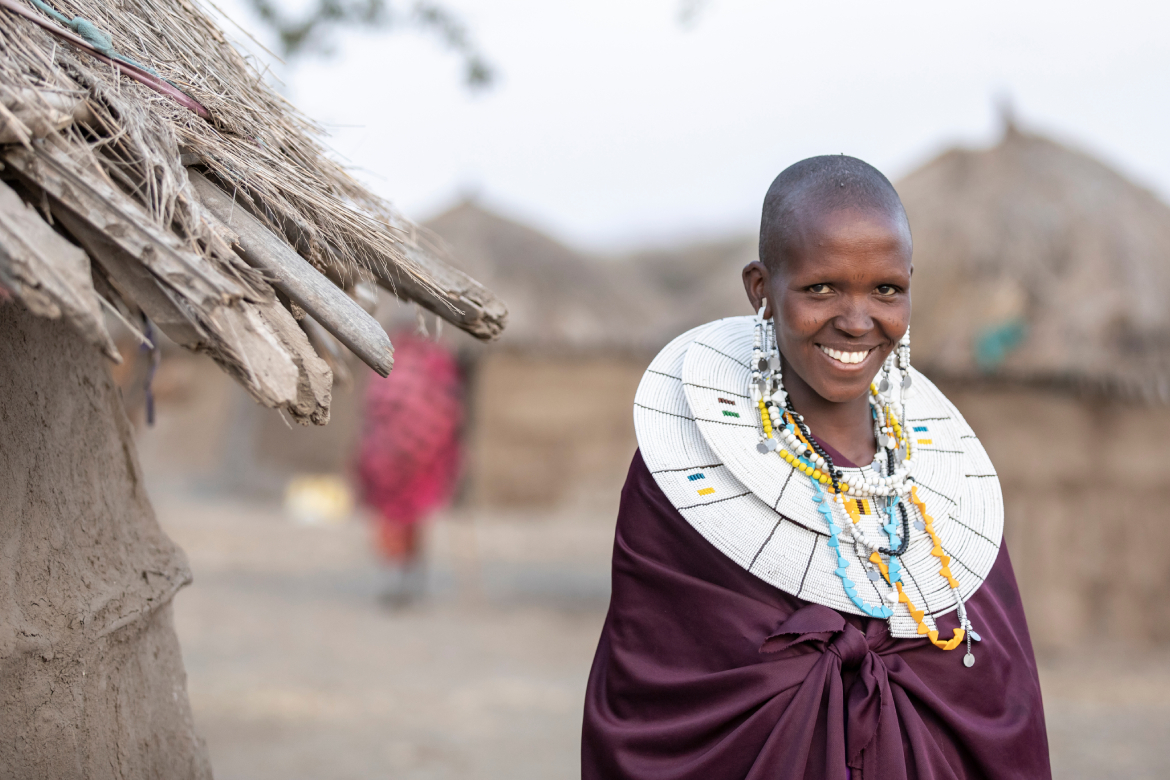
Maasai Women in Arusha, Tanzania (Photo by Emily Pennington)
Abercrombie & Kent prides itself on procuring the best guides in the business, with a special focus on expert wildlife spotting and unique cultural immersions, and my tour director, Kelvin Kinabo, was no exception. Raised by a Maasai mother, with years of in-the-field experience on Tanzania’s anti-poaching squad, followed by more than a decade of guiding trips for A&K, he was the sort of extremely knowledgeable and patient kingpin you’d hope for when setting off into the vast unknown. No matter how many questions I asked him, or random animals I pointed to, he was never once stumped.
After a quick briefing on basic safari etiquette (keep your limbs inside the Jeep at all times and, for god’s sake, lower your voice if there’s a lion around) our group of eight boarded a shuttle bus to visit Ilboru Primary School (akphilanthropy.org), one of Abercrombie & Kent’s dedicated philanthropy projects designed to give back to countries where they operate tours.
A gaggle of school boys in bright cerulean uniforms sprinted alongside our bus as we pulled up to the dusty buildings. Paraded by a chorus of giggles, we were led inside and given a tour by the school’s founder who ran us through some of the different learning facilities for these special needs kids. In Tanzanian culture, it is considered bad luck to have a child with a disability, and our guide Kelvin explained that, not long ago, many of these kids might have been killed by their own families, rather than suffer the social stigma of being different. When the time came to leave, I gave dozens of hugs and breathed a small sigh of relief, knowing I was traveling with an organization that cared about inclusivity.
TARANGIRE NATIONAL PARK
Now it was time for our first national park, Tarangire (tarangiretanzania. com). We boarded a 12-seater propeller plane and watched the earth shrink below us as we passed barren plots of recently harvested land and countless Maasai villages.
Though Tarangire is known for its healthy elephant population, I was surprised to spot a large group of them relaxing near a watering hole before the wheels of the plane had even touched down. I felt my heart leap into my throat. Somehow, I could sense that the Africa I had seen for years in picture books and television shows was about to become a heck of a lot more visceral.
Kelvin had arranged an afternoon game drive on the way to camp, so we hopped into a pair of customA&K Jeeps and took off into the rust-red dust. Mere seconds later, we were all gasping with surprise and begging our driver, Kaswa, to pull over for photo breaks each time we spotted an impala or an errant set of black and white zebra stripes. A lithesome giraffe stood stock-still in a cluster of trees. A pair of tiny dik-diks paced in the shade of a nearby shrub, while a bush buck grazed on a termite mound.
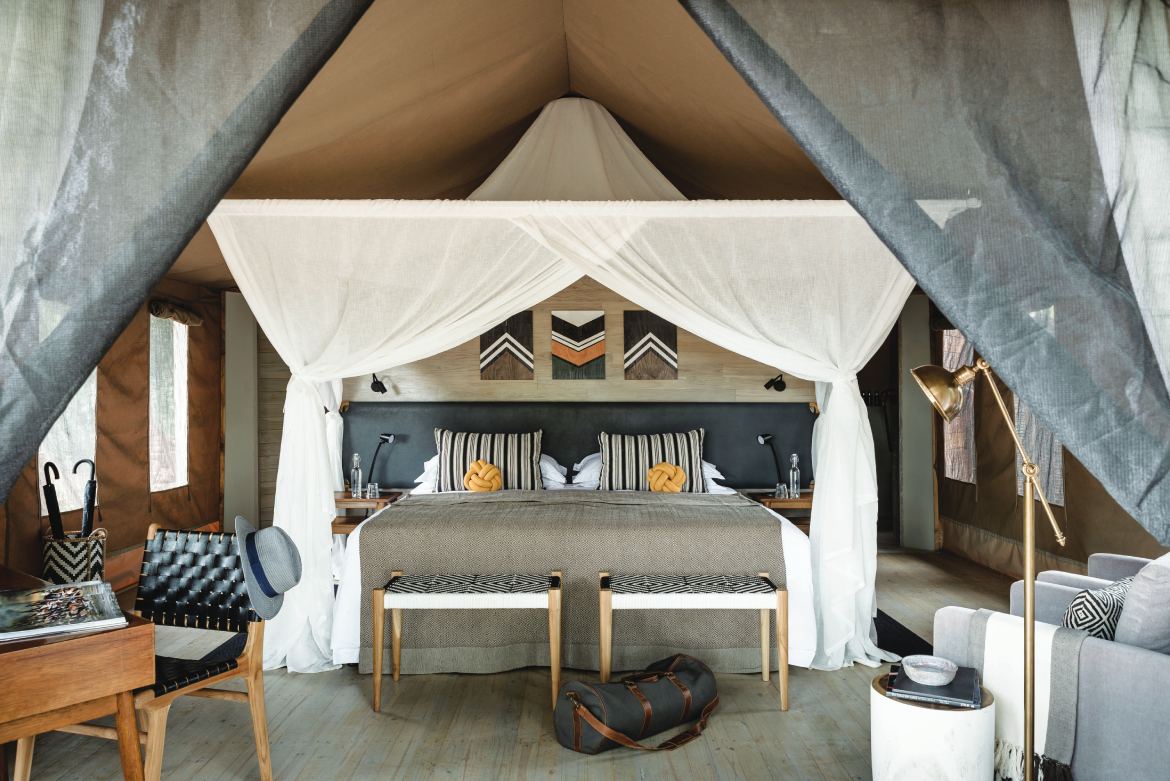
Sanctuary Swala (Photo courtesy Abercrombie & Kent)
Tanzania has an outstanding reputation for preserving its natural landscapes. Roughly 37 percent of the country is covered by some form of conservation rules, with a tapestry of twenty-two national parks offering the highest protections for native flora and fauna.
We arrived at our first camp, Sanctuary Swala (sanctuaryretreats.com), to a warm welcome from the local staff, and, after a quick look at my posh new tent accommodations, dinner was served in the neighboring dining structure. The tour was all-inclusive, so everything from cocktails to tailored wine pairings was included. I gorged myself on potato and leek soup, followed by local tilapia with freshly minced vegetables, eventually dozing off to the frenetic soundtrack of the African bush at night.
Like a kid too excited for Christmas morning, I slept fitfully and rose at dawn to a playful symphony of birds and monkeys. It was our first full day on safari, and my anticipation was bursting at the seams. I spent the day barefoot with the wind in my hair, standing on one of our Jeep’s plush seats to glean the best views from my vantage point peeking out of its pop-up roof. I quickly learned that, in Africa, zebras are like squirrels or pigeons, and, after a few choice photos, our guides started speeding past them in search of bigger game.
Huge herds of elephant families roamed amongst umbrella-like acacia trees, and troops of olive baboons foraged beneath the spindly canopy of an ancient baobab tree. All at once, our Jeeps veered slightly off road, nearly jostling my camera into the face of one of my fellow travelers. “Sorry about the bumps,” Kelvin shouted above the hum of the engine. “This is what we like to call a free African massage.”
I looked to my left and came face-to-face with a pair of male lions, not twenty feet from the vehicle. “Look at their manes, these lions are still young. They could be brothers, I think,” Kelvin whispered as a dozen camera clicks went off.
Our lunch spot that afternoon was tremendous. Set on a hilltop overlooking a green, marshy area that served as one of the park’s main watering holes, we had a bird’s-eye view of thousands of roaming wildebeest and
cape buffalo. I returned to camp in a state of euphoria, plopping my camera onto the bed to indulge in my private outdoor shower. Streams of warm water ran down my body while a clan of vervet monkeys played and foraged in the baobab branches above.
When I emerged for dinner, a herd of elephants, fifty strong, was leisurely strolling towards our encampment. I grabbed my phone and my camera and set up shop in the bar tent with a local Safari Lager in hand, mouth agape as the band of truck-sized beasts politely meandered between our rooms. I watched, utterly awestruck, until the sun went down and the sky turned to black.
As if the day wasn’t eventful enough, I had scheduled a night tour after supper with one of my fellow camp mates. With a breeze rustling the leaves of nearby bushwillows, we hopped into an open-air Jeep and quickly learned just how wild an after-hours safari can be.
We were each handed a flashlight and a set of binoculars and told to keep our eyes peeled for sets of red, glowing eyes in the darkness, a key sign that we were observing a nocturnal mammal. The engine roared to life, and our driver quickly sped down a dirt road frantically shining his bright spotlight into every tree and shrub we came upon. The brakes lurched, and to my right was a catlike creature with a long, striped tail. “A genet,” our driver mumbled. We took a few photos and sped off into the night.
Suddenly, the guide pointed far off to the left and brought our vehicle to a halt. Something was lurking in the tall grass. “Is it a leopard?” I asked, dazed by the frenetic effort of searching in the darkness. “Yes,” he replied. “I think she’s stalking something, maybe a small reedbuck.” By the time we made it back to camp, two hours later, we’d spotted yet another leopard and a large serval. My head spinning from all I’d seen in such a short time, I flopped onto my cushy mattress and fell asleep instantly.
NGORONGORO CRATER
After one too many cups of coffee, I stepped back into the A&K Jeep for the long and bumpy drive to Ngorongoro Crater Conservation Area. Maasai villagers drove their cattle with long sticks on the outskirts of Tarangire, and soon we were back on a paved highway, stopping in the small township of Mto Wa Mbu for a fast-paced tuk tuk tour through the community’s thriving market and banana plantation.
Lunch was a truly luxe affair, with a stop at organic, century-old Gibbs Farm (gibbsfarm.com) for a three-course meal overlooking verdant fields of produce from their al fresco dining patio. My selections? A tangy Greek salad, followed by a vegan version of a traditional Tanzanian meal, complete with ugali, fresh veggies, and a perfectly-seasoned bean stew. For dessert, I had the poached tamarillo with caramel sauce and watermelon sorbet, naturally.
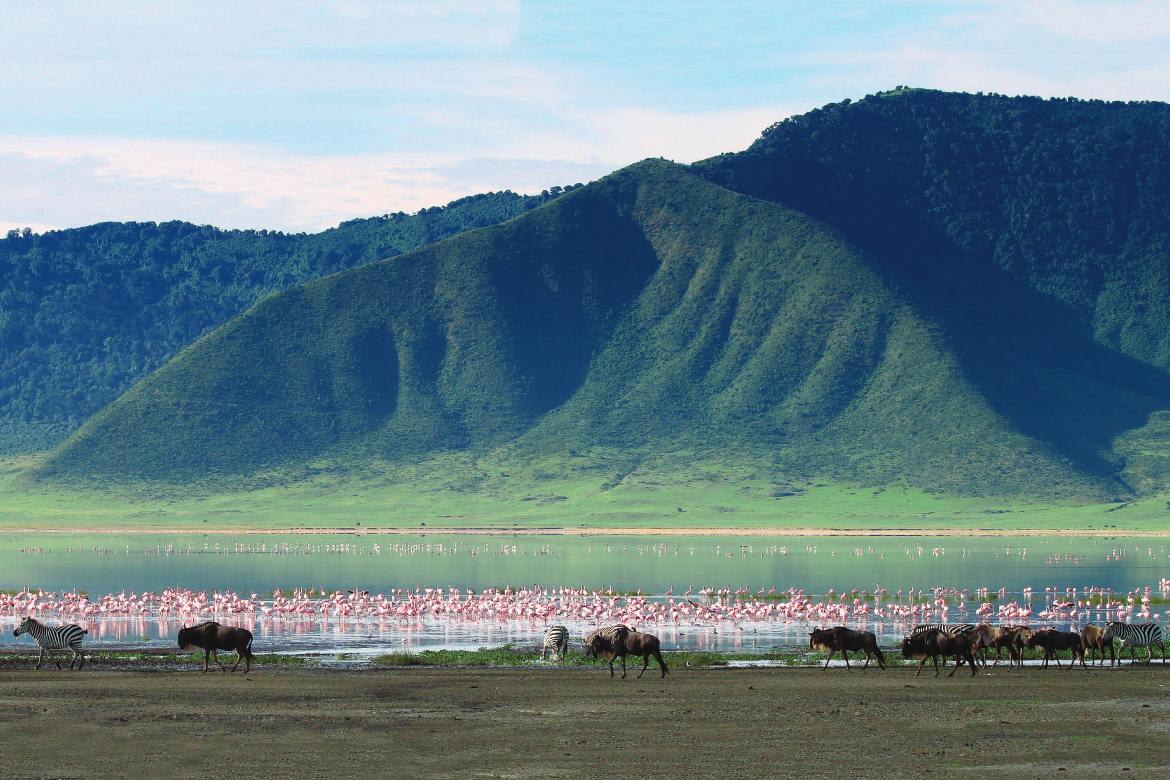
Ngorongoro Crater, Tanzania (Photo by Travel Stock)
As we wheeled into our jewel of a camp, Sanctuary Ngorongoro Crater (sanctuaryretreats.com), the sun had turned its dial to magic hour, and a faint glow of pink settled amidst the flat-topped acacia trees. Being a full 4,000 feet higher than our previous stay, there was a discernable chill to the night air that made me want to nestle into my bed’s thick blankets and read until sleep came. Kelvin warned us that we had an early morning start.
I rose at 5 A.M., then hopped into a patiently waiting Jeep for our earliest game drive of the trip. Kelvin wanted to beat the torrent of day tours leaving Arusha, so we arrived at the crater floor at the bleary hour of 6:15 A.M. Right away, we spotted two shy bat-eared foxes and a lone ostrich, like silent sentinels blessing what was sure to be an epic day out.
Soon, I was practically living inside an episode of Planet Earth. A pride of lions sauntered across the road and nuzzled each other in the cool morning light. Squat warthogs knelt and grazed on fields surrounding a lake that held dozens of hippopotamuses and flamingos. Skittish hyenas tossed a bit of last night’s carcass between their mates, and stone-faced wildebeest quietly grazed in the distance.


